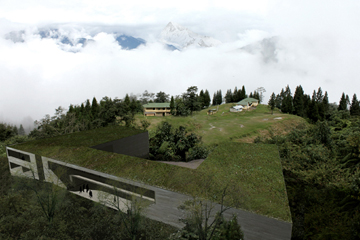Sikkim Biodiversity Training Institute, India
The North Indian state Sikkim, strengthens their approach towards environmental friendly strategies. OIII Architects and Architecture BRIO have been appointed via an international tender to design the Biodiversity Training Institute of Sikkim.
The building with educational and residential facilities will be characterized by green features that derive from re-using and reinterpretation of local techniques and knowledge.
Sikkim is an Indian state in the Hymalaya’s in between Nepal, Bhutan and Tibet. The state is know for its rich and diverse flora and fauna. The landscape varies from dense green forests to the high snow covered mountains in the North.
Sikkim introduced a green mission to emphasize and cherish the magnificent nature. The Sikkimese respect their environment and are developing and studying strategies how to keep economic growth and increase of tourism in a harmonic relation with nature.
The Sikkim Biodiversity Forest Department (SBFP) initiated a series of architectural projects to set an example of how to deal with urban planning and buildings that blend with nature.
One of the projects is the Biodiversity Training Institute. The site is located near Sikkim’s capital Gantok, placed on a slope it faces world third highest mountain, the Kanchenjunga. Spaces like training halls, workshop space, conference auditorium, library, research labs and residential facilities will face this wonderful view. It will become a place for education on Himalayan flora and fauna and an example environmental friendly building design.
The vision of OIII and BRIO explains development strategies by using local techniques and knowledge. The design of the building is compact with a small footprint and makes use of solar energy, local vegetation and wind. Thermal mass of the walls will be used to create moderate fluctuations in temperature. Local material like rammed earth and natural stone are chosen to create accumulating qualities of walls and floors. The divers vegetation of Sikkim will become an integral part of the building such as the vegetated roof with local plants.
A place for education, exchange of knowledge, to meet each other and an inspirational example of the Sikkimese ‘green mission’.

